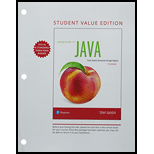
Concept explainers
Conversion
Write a program that asks the user to enter a distance in meters. The program will then present the following menu of selections:
- 1. Convert to kilometers
- 2. Convert to inches
- 3. Convert to feet
- 4. Quit the program
The program will convert the distance to kilometers, inches, or feet, depending on the user’s selection. Here are the specific requirements:
- • Write a void method named showKi1ometers, which accepts the number of meters as an argument. The method should display the argument converted to kilometers. Convert the meters to kilometers using the following formula:kilometers = meters * 0.001
- Write a void method named showlnches, which accepts the number of meters as an argument. The method should display the argument converted to inches. Convert the meters to inches using the following formula:inches = meters * 39.37
- Write a void method named showFeet, which accepts the number of meters as an argument. The method should display the argument converted to feet. Convert the meters to feet using the following formula:feet = meters * 3.281
- Write a void method named menu that displays the menu of selections. This method should not accept any arguments.
- The program should continue to display the menu until the user enters 4 to quit the program.
- The program should not accept negative numbers for the distance in meters.
- If the user selects an invalid choice from the menu, the program should display an error message.
Here is an example session with the program, using console input. The user’s input is shown in bold.
Enter a distance in meters: 500 [Enter]
- 1. Convert to kilometers
- 2. Convert to inches
- 3. Convert to feet
- 4. Quit the program
Enter your choice: 1 [Enter]
500 meters is 0.5 kilometers.
- 1. Convert to kilometers
- 2. Convert to inches
- 3. Convert to feet
- 4. Quit the program
Enter your choice: 3 [Enter]
500 meters is 1640.5 feet.
- 1. Convert to kilometers
- 2. Convert to inches
- 3. Convert to feet
- 4. Quit the program
Enter your choice: 4 [Enter]
Bye!
Learn your wayIncludes step-by-step video

Chapter 5 Solutions
Starting Out With Java: From Control Structures Through Objects, Student Value Edition (7th Edition)
Additional Engineering Textbook Solutions
Starting Out with Python (4th Edition)
Mechanics of Materials (10th Edition)
Problem Solving with C++ (10th Edition)
SURVEY OF OPERATING SYSTEMS
Degarmo's Materials And Processes In Manufacturing
Starting Out with Java: From Control Structures through Data Structures (4th Edition) (What's New in Computer Science)
- what is a feature in the Windows Server Security Compliance Toolkit, thank you.arrow_forwardYou will write a program that allows the user to keep track of college locations and details about each location. To begin you will create a College python class that keeps track of the csollege's unique id number, name, address, phone number, maximum students, and average tuition cost. Once you have built the College class, you will write a program that stores College objects in a dictionary while using the College's unique id number as the key. The program should display a menu in this order that lets the user: 1) Add a new College 2) Look up a College 4) Delete an existing College 5) Change an existing College's name, address, phone number, maximum guests, and average tuition cost. 6) Exit the programarrow_forwardShow all the workarrow_forward
- Show all the workarrow_forward[5 marks] Give a recursive definition for the language anb2n where n = 1, 2, 3, ... over the alphabet Ó={a, b}. 2) [12 marks] Consider the following languages over the alphabet ={a ,b}, (i) The language of all words that begin and end an a (ii) The language where every a in a word is immediately followed by at least one b. (a) Express each as a Regular Expression (b) Draw an FA for each language (c) For Language (i), draw a TG using at most 3 states (d) For Language (ii), construct a CFG.arrow_forwardQuestion 1 Generate a random sample of standard lognormal data (rlnorm()) for sample size n = 100. Construct histogram estimates of density for this sample using Sturges’ Rule, Scott’s Normal Reference Rule, and the FD Rule. Question 2 Construct a frequency polygon density estimate for the sample in Question 1, using bin width determined by Sturges’ Rule.arrow_forward
- Generate a random sample of standard lognormal data (rlnorm()) for sample size n = 100. Construct histogram estimates of density for this sample using Sturges’ Rule, Scott’s Normal Reference Rule, and the FD Rule.arrow_forwardCan I get help with this case please, thank youarrow_forwardI need help to solve the following, thank youarrow_forward
 EBK JAVA PROGRAMMINGComputer ScienceISBN:9781305480537Author:FARRELLPublisher:CENGAGE LEARNING - CONSIGNMENTProgramming Logic & Design ComprehensiveComputer ScienceISBN:9781337669405Author:FARRELLPublisher:Cengage
EBK JAVA PROGRAMMINGComputer ScienceISBN:9781305480537Author:FARRELLPublisher:CENGAGE LEARNING - CONSIGNMENTProgramming Logic & Design ComprehensiveComputer ScienceISBN:9781337669405Author:FARRELLPublisher:Cengage EBK JAVA PROGRAMMINGComputer ScienceISBN:9781337671385Author:FARRELLPublisher:CENGAGE LEARNING - CONSIGNMENT
EBK JAVA PROGRAMMINGComputer ScienceISBN:9781337671385Author:FARRELLPublisher:CENGAGE LEARNING - CONSIGNMENT C++ Programming: From Problem Analysis to Program...Computer ScienceISBN:9781337102087Author:D. S. MalikPublisher:Cengage Learning
C++ Programming: From Problem Analysis to Program...Computer ScienceISBN:9781337102087Author:D. S. MalikPublisher:Cengage Learning Programming with Microsoft Visual Basic 2017Computer ScienceISBN:9781337102124Author:Diane ZakPublisher:Cengage Learning
Programming with Microsoft Visual Basic 2017Computer ScienceISBN:9781337102124Author:Diane ZakPublisher:Cengage Learning Microsoft Visual C#Computer ScienceISBN:9781337102100Author:Joyce, Farrell.Publisher:Cengage Learning,
Microsoft Visual C#Computer ScienceISBN:9781337102100Author:Joyce, Farrell.Publisher:Cengage Learning,





